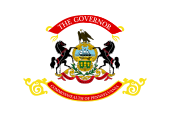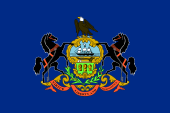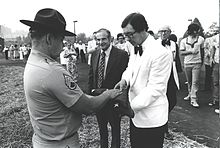- Milton Shapp
-
Milton Shapp 40th Governor of Pennsylvania In office
January 20, 1971 – January 16, 1979Lieutenant Ernest P. Kline Preceded by Raymond P. Shafer Succeeded by Dick Thornburgh Personal details Born June 25, 1912
Cleveland, OhioDied November 24, 1994 (aged 82)
Merion, PennsylvaniaAlma mater Case Western Reserve University Profession Businessman, Politician Religion Judaism Milton Jerrold Shapp (June 25, 1912 - November 24, 1994) was the 40th Governor of the U.S. state of Pennsylvania from 1971 to 1979 and was the first Jewish governor of Pennsylvania.
Contents
Early life
Shapp was born Milton Jerrold Shapiro in Cleveland, Ohio to Aaron Shapiro, a Jewish businessman and staunch Republican and Eva Smelsey Shapiro, a Democrat and outspoken suffragette. He attended Case Institute of Technology (now Case Western Reserve University) graduating in 1933 with a degree in electrical engineering. The effects of the Great Depression ravaged America and Shapp was unable to find work in the engineering field. Instead he worked as a coal truck driver. In 1936, he took a job selling electronic parts and moved to Pennsylvania. It was during this time that he changed his name from Shapiro to Shapp to avoid antisemitic prejudice though he continued to openly identify as a Jew.
During World War II, Shapp served as an officer in the U.S. Army Signal Corps in North Africa and Europe. After World War II, he moved to Philadelphia and founded Jerrold Electronics Corporation, a pioneer in the cable television industry, using a $500 loan subsidized by the G.I. Bill. Jerrold became one of America’s first providers of coaxial cable TV systems in 1948. Jerrold Electronics became a major player in the television industry and Shapp became a multi-millionaire. Shapp sold his interest in Jerrold Electronics in 1967 to the General Instrument Company to concentrate on politics.
Enters politics
Shapp first entered the political scene in 1960 by campaigning for John F. Kennedy. Shapp is “credited with promoting the idea that eventually led to the creation of the Peace Corps.”[1] After Kennedy was elected President Shapp served as an advisor to the Peace Corps[2] as well as consultant to the Secretary of Commerce.
In 1966, he sought the Democratic nomination for Governor of Pennsylvania. The party in Pennsylvania was deeply divided that year and the party officially endorsed Robert P. Casey for the office. Shapp’s large personal fortune allowed him to run an independent campaign, and he capitalized on an anti-establishment mood among Democrats and won the Democratic primary by about 50,000 votes with a slogan portraying him as "The Man Against The Machine."
During the time, Shapp was heavily involved in trying to stop the merger of the Pennsylvania Railroad with the New York Central. He invested millions of dollars of his own money into the effort, travelling throughout Pennsylvania to convince local officials to oppose the merger. He pushed the issue into the federal courts and testified against the proposed merger in front of the Interstate Commerce Commission.
The issue was prominent during his first run for governor in 1966. In the process, he made several enemies. Stuart T. Saunders, president of the Pennsylvania Railroad, opposed Shapp at every turn. Friendly with the Lyndon Johnson administration, Saunders influenced Washington Democrats to sabotage the Shapp campaign. Additionally, Walter Annenberg, owner and publisher of The Philadelphia Inquirer and major shareholder of the Pennsylvania Railroad, used the pages of The Inquirer to cast doubt on Shapp's candidacy. The opposition from Annenberg-owned media and the Democratic political establishment helped contribute to Shapp's narrow loss that year to Republican Raymond P. Shafer.
Governor of Pennsylvania
As the 1970 state elections approached, Shafer was term-limited under existing Pennsylvania law and could not run for re-election. Furthermore, a fiscal crisis during his term caused his popularity to be at a low point hurting Republican chances of retaining the office. Shapp again sought the Democratic nomination and again defeated Robert P. Casey to win the Democratic nomination. Of his nemeses from the last election, Walter Annenberg had sold the Inquirer to Knight Newspapers, Inc. a year earlier prior to his appointment as Ambassador to the United Kingdom, while Stuart Saunders had vanished from the political scene as Penn Central entered bankruptcy in 1970.[3] This time Shapp was elected Governor of Pennsylvania over Republican Raymond J. Broderick, the incumbent Lieutenant Governor and later a well-respected federal judge, by over 500,000 votes.
During Shapp’s time in office, he solved a financial crisis by instituting Pennsylvania's flat, no-deductions income tax. He also signed into law the bill creating the Pennsylvania Lottery and instituted major reforms for the Pennsylvania Turnpike. The Governor oversaw new consumer rights legislation, welfare reform, and insurance reform including the controversial decision to enact no-fault insurance legislation in the state. In the wake of the Watergate crisis, he established a sweeping Sunshine Law for the state, the most comprehensive of any state at the time.
He also faced a massive recovery effort after Hurricane Agnes caused widespread flooding in the state causing the death of 48 Pennsylvanians. The flooding was so bad and so rapid that Governor Shapp and his wife, Muriel, had to be rescued from the governor’s mansion in Harrisburg by boat as flood waters from the Susquehanna River inundated the building. He was carried from the executive mansion to the boat on the back of a State Trooper. WHP-TV covered this evacuation.
No longer limited to one term, Shapp was reelected governor by a large majority in 1974. He set his sights on the White House and ran unsuccessfully for the 1976 Democratic nomination for President, but failed to win even his home state of Pennsylvania in the primary elections and dropped out after an 89-day campaign.[1] After that defeat, he settled into a lame-duck term as governor, enacting no further significant reforms.
His administration was plagued with numerous scandals during his tenure in the governor's mansion. Although generally regarded as personally honest and never personally implicated in any of the scandals, he was heavily criticized for not doing enough to prevent corruption among his subordinates in the state executive branch.
Governor Shapp opposed capital punishment and vetoed an attempt to restore it in Pennsylvania in 1974. The legislature, however, overrode the veto and reinstated the death penalty[4].
Later years and death
Shapp died on November 24, 1994, aged 82. After his death, Motorola corporation established the Milton Jerrold Shapp Memorial Scholarship Fund, an engineering scholarship in Shapp's honor. Motorola was the successor corporation to General Instrument, the company that had acquired Shapp’s firm in 1967.
References
- ^ a b Pierre-Pierre, Garry (26 November 1994). "Milton J. Shapp Is Dead at 82: Ex-Governor of Pennsylvania". The New York Times. http://www.nytimes.com/1994/11/26/obituaries/milton-j-shapp-is-dead-at-82-ex-governor-of-pennsylvania.html.
- ^ Pennsylvania Governor Milton Jerrold Shapp, National Governors Association
- ^ Daughen, Joseph R. & Peter Binzen (1971). The Wreck of the Penn Central. Boston: Little, Brown. ISBN 1-893122-08-5.
- ^ Death Penalty in Pennsylvania - Statistics & History of Capital Punishment in PA
Political offices Preceded by
Raymond ShaferGovernor of Pennsylvania
1971 – 1979Succeeded by
Dick ThornburghParty political offices Preceded by
Richardson DilworthDemocratic nominee for Governor of Pennsylvania
1966 (lost), 1970 (won), 1974 (won)Succeeded by
Pete FlahertyGovernors, Lieutenant Governors, Presidents and Vice-Presidents of Pennsylvania Governor 
Presidents
(1777–1790)Governors
(since 1790)Mifflin · McKean · Snyder · Findlay · Hiester · Shulze · Wolf · Ritner · Porter · Shunk · Johnston · Bigler · Pollock · Packer · Curtin · Geary · Hartranft · Hoyt · Pattison · Beaver · Pattison · Hastings · Stone · Pennypacker · Stuart · Tener · Brumbaugh · Sproul · Pinchot · Fisher · Pinchot · Earle · James · Martin · Bell · Duff · Fine · Leader · Lawrence · Scranton · Shafer · Shapp · Thornburgh · Casey · Ridge · Schweiker · Rendell · CorbettLieutenant Governors 
Vice-Presidents
(1777–1790)Lieutenants Governors
(since 1875)United States presidential election, 1976 Democratic Party
Convention · PrimariesNominee: Jimmy Carter
VP Nominee: Walter Mondale
Candidates: Birch Bayh · Lloyd Bentsen · Jerry Brown · Robert Byrd · Hugh Carey · Frank Church · Fred R. Harris · Hubert Humphrey · Henry M. Jackson · Leon Jaworski · Barbara Jordan · Eugene McCarthy · Ellen McCormack · Walter Mondale · Jennings Randolph · Terry Sanford · Milton Shapp · Sargent Shriver · Adlai Stevenson III · Mo Udall · George WallaceRepublican Party
Convention · PrimariesNominee: Gerald Ford
VP Nominee: Bob Dole
Candidiates: James L. Buckley · Ronald Reagan · Harold StassenThird party and independent candidates American Party American Independent Party Communist Party USA Libertarian Party People's Party Prohibition Party Socialist Workers Party U.S. Labor Party Categories:- 1912 births
- 1994 deaths
- American military personnel of World War II
- Democratic Party state governors of the United States
- Governors of Pennsylvania
- Jewish American governors
- American Jews
- Pennsylvania Democrats
- People from Cleveland, Ohio
- United States Army officers
- United States presidential candidates, 1976
Wikimedia Foundation. 2010.

